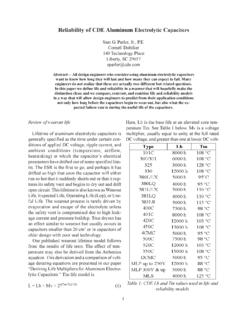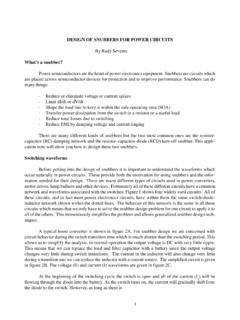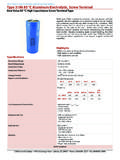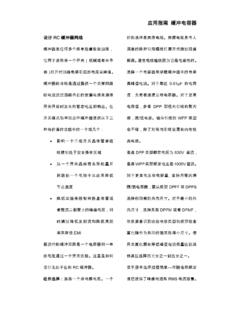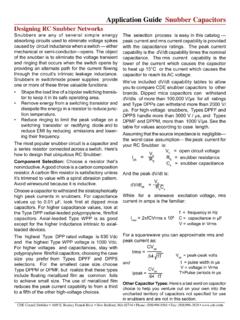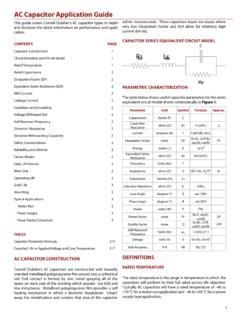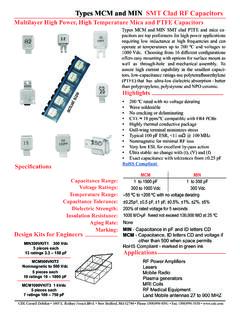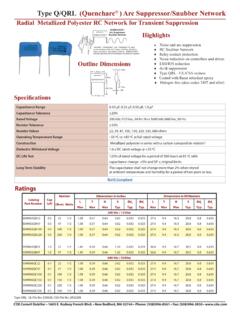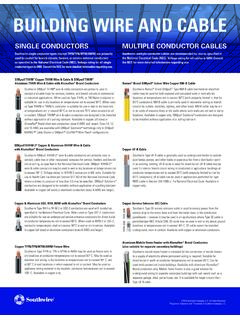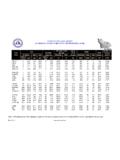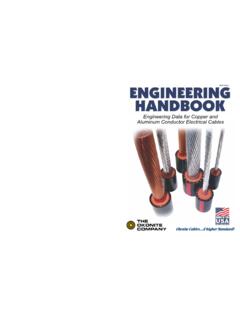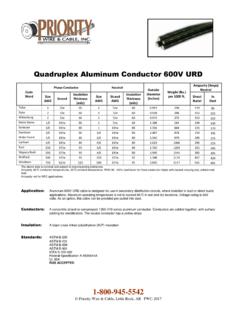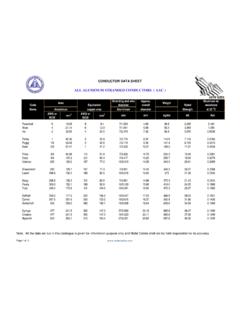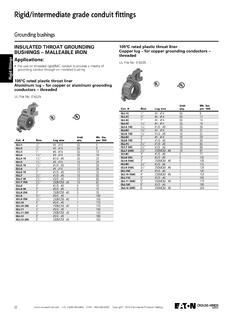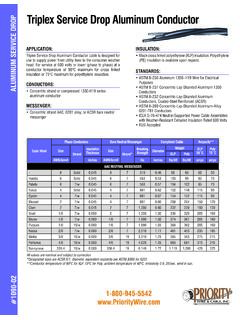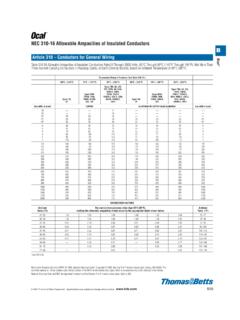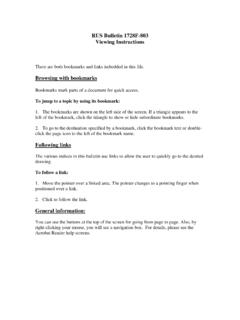Transcription of Aluminum Electrolytic Capacitor Application Guide
1 CDM Cornell Dubilier 140 Technology Place Liberty, SC 29657 Phone: (864)843-2277 Fax: (864)843-3800 1 Index / Table of Contents** Navigational Note: Jump to The Relevant Topic by Clicking **Scope of This Application 1: Parameters and Variables Related to CapacitorsConstruction Overview ..Production Process Characteristics and How to Measure Cs, Resistance Rs, Inductance Ls, Capacitor Impedance Z, DC Leakage Resistance Rl and Leakage Current (DCL), Typical Initial DCL Versus Voltage and Temperature, Zener Diode DzGeneral Limitations, Additional Characteristics and Test Temperature Range; Storage Temperature Range, Short-Term and Long-Term; Shelf Life Test; Re-Ageing, Re-Forming, Reconditioning of High DCL Capacitors; Rated DC Voltage; Rated Surge Voltage; Surge Voltage Test; Reverse Voltage; Transient Overvoltage; Ripple Current Transients and High Inrush Current; Charge-Discharge Duty and High Peak-To-Peak Voltage; Insulation and Grounding, Case and Dummy Pins, Sleeving; Elevation (Altitude) and External Pressure; Mechanical Vibration and Shock; Thermal Cycle, Immersion and Thermal Shock; Polarity Reverse Voltage.
2 Anti-Series Connection, Non-Polar, AC and Motor-Start Capacitors; Self-Resonant Frequency; Dielectric Absorption (DA) Capacitor Bank Considerations, Parallel Connection, Bus Structure, Fusing and Soft Start, Series Connection, Voltage Sharing, Balancing Resistors, Parallel/Series Bank, Series/Parallel BankReliability and Model, The Bathtub Curve ; Ripple Current, Load Life Tests, Ripple Multipliers; Ripple Multiplier Tables; Operating Lifetime Model; Table of Base Lifetime Lb and Maximum Core Temperature Tm; Lifetime Calculations for Varying Ambient Temperature or Varying Ripple Current; Load Life Test; EIA Ripple Life Test; EIA IS-749; Estimating Lifetime for Capacitors without an Online CalculatorCooling and Thermal Strategies, Thermal ResistanceProcess , Wave and Reflow Soldering Tips, Care After Soldering, Handling Circuit Board Assemblies, Halogenated-Solvent Cleaning, Aqueous Cleaning, Alcohol and Solvent Cleaning to Remove Solder Flux Residue, Cleaning Precautions, Potting and Gluing, Fumiga-tion Position, Position of the Pressure-Relief Vent, Printed-Circuit Board PrecautionsHandling Terminals, Screw-Terminal Torque, Screw-Terminal Current Rating, Mounting-Stud TorqueSafety Shock Hazard, Pressure-Relief Vent, Contact with Electrolyte, FlammabilityDisposal of , Testing and Environmental and Electrolytic Capacitor Application Guide123457101214152021212222 SCOPE OF THIS Application GUIDEThis Guide covers the Application of polar.
3 Non-solid Aluminum Electrolytic capacitors, which are those Aluminum Electrolytic capacitors featuring a wet, aqueous electrolyte with separator membranes such as cellulosic papers between two Aluminum foils. Other types of Aluminum Electrolytic capacitors not cov-ered include the obsolete wet types without separator mem-branes, hybrid Aluminum Electrolytic capacitors containing both polymer and liquid electrolyte components and sol-id-polymer Electrolytic capacitors. This Application Guide focus-es on the Application of polar, non-solid Aluminum Electrolytic capacitors used in ripple-filtering applications such as used as input and output capacitors in linear and switch-mode power supplies and inverters. This Guide does not cover in detail, ap-plication of non-polar Aluminum Electrolytic capacitors such as AC motor-start capacitors. Photoflash, strobe, pulse discharge and charge-discharge specialty capacitors are not covered.
4 In the case where there is a disagreement between statements made in this Application Guide and the individual technical datasheet for a Capacitor series or an individual Capacitor , the latter should be used as the authority. For technical questions on topics not covered in this Application Guide , please contact Cornell Dubilier 140 Technology Place Liberty, SC 29657 Phone: (864)843-2277 Fax: (864)843-3800 Table 1: Parameters and variables related to capacitorsCONSTRUCTION OVERVIEWAn Aluminum Electrolytic Capacitor consists of a wound capac-itor element, impregnated with liquid electrolyte, connected to terminals and sealed in a can. See Figures 1 and 2. Voltage ratings are classified as < 100 VDC for low voltage, 101-250 for mid-voltage and 251-700 for high voltage. Typical case volumes range from a few cubic centimeters in radial and axial leaded configurations to over one liter in the largest screw-terminal sizes.
5 Between these extremes there are many snapmount and screw-terminal sizes ranging from about 10 to 1,000 cc s. Typi-cal capacitance ranges are 10 F to 3 farads in the low-voltage range, 5 F to farads in the mid-voltage range, and 2 to 40,000 F in the high-voltage Cornell Dubilier capacitors use compression-fit construction so there is no thermoplastic potting compound to interfere with safety vent operation. Thermal Pak and Rilled are Cornell Du-bilier s exceptional constructions for screw terminal capacitors. Compared to conventional, potted construction, Thermal Pak operates cooler, provides longer life, withstands higher shock and vibration, delivers more reliable safety vent operation and is lighter in weight. Rilled construction offers superior shock and vibration withstanding, typically withstanding more than 15 g acceleration and VariablesCDM Cornell Dubilier 140 Technology Place Liberty, SC 29657 Phone: (864)843-2277 Fax: (864)843-3800 3 Figure 1: Winding constructionFigure 2: Capacitor construction variationsPRODUCTION PROCESS OVERVIEWF igure 3 shows the production processes.
6 The anode Aluminum foil is etched to increase the surface area, and is later anodized during the Forming process, which grows a thin Aluminum ox-ide insulating coating to a thickness that provides an electrical insulation up to a potential known as the formation voltage, which is always substantially higher than the Capacitor s rated DC voltage. As the formation process progresses, the thickening dielectric coating reduces the microscopic surface area of the etched foil because the etch tunnels become partially occluded by the oxide. So, for a given etched foil as the formation voltage is increased, the capacitance per macroscopic area drops dra-matically because the area contacting the electrolyte is decreas-ing while the thickness of the dielectric is increasing. Increasing the formation voltage and thus the dielectric thickness by 10% would typically result in a capacitance decrease of 13%, re-sulting in a charge storage decrease of 5% and an energy stor-age increase of 5% at the higher formation voltage.
7 Figure 3: Capacitor manufacturing processThe anode foil etch pattern is optimized for high capacitance or low ESR over a range of formation voltages by choice of foil thickness, alloy, grain structure (cubicity), and etching and forming geometries governed by electrolyte compositions and electrical waveforms. Thus low-voltage anodes have denser tunnel patterns compatible with thin oxide and high-voltage anodes have coarser tunnel patterns compatible with thick ox-ide. The cathode foil is etched in a different manner than the anode foil, and may be stabilized or passivated but does not usually go through a Forming process. The anode and cathode foil rolls typically weigh about 100 kg (220 pounds) and are nearly meters (20 inches) wide during the foil processing, and are cut into narrower rolls during the Slitting process.
8 During the Winding process, the anode foil, cathode foil and multiple separator papers are wound together. One or more pairs of Aluminum ribbons known as tabs are attached to the foils prior to or during Winding. During the Impregnation pro-4 CDM Cornell Dubilier 140 Technology Place Liberty, SC 29657 Phone: (864)843-2277 Fax: (864)843-3800 cess, the liquid electrolyte saturates the winding. The top with terminals may be attached to the tabs of the winding before or after impregnation. In an axial-leaded Capacitor , the can is at-tached to the negative tab(s).During the Sealing process, the Capacitor element is sealed into an outer package, usually made of Aluminum , but sometimes stainless steel or other material. To control pressure build-up, the seal is not usually hermetic but rather a pressure closure made by rolling the can edge into a rubber gasket, a rubber end-plug or into rubber laminated to a phenolic board.
9 Unless specially constructed, too tight a seal may cause excessive pressure build up; while too loose a seal shortens the lifetime by permitting dry-out, which is evaporative loss of electrolyte. After the capac-itor is sealed, it is usually washed to remove electrolyte residue from the outside of the the Ageing process, a DC voltage greater than the rat-ed voltage but less than the formation voltage is applied to the Capacitor . Usually the voltage is applied at the Capacitor s rated temperature, but other temperatures may be used depending upon performance goals. This process re-forms the edges and any damaged spots on the anode foil such as where the tabs were attached. And bare areas or damaged dielectric is repaired with fresh Aluminum oxide dielectric. Proper ageing reduces the instance of early Application failures (infant mortals).
10 Low initial DC leakage current is a sign of effective ageing. After ageing, the Capacitor is tested, sleeved and labeled, packed and finally shipped. DEVICE PHYSICSA Capacitor is physically created when two conductors are sep-arated by an insulator known as a dielectric. While it may at first appear that an Electrolytic Capacitor is two conductive alumi-num foils separated by an insulating fluid, this is not the situa-tion because the electrolyte is ionically conductive, and is not an insulating fluid. The actual dielectric is the very thin Aluminum oxide (anodic alumina) on the highly etched 3D surface of the anode foil. The etch pattern typically comprises billions of micro-scopic tunnels 107/cm is typical for a high-voltage anode to increase the surface area in contact with the electrolyte.
